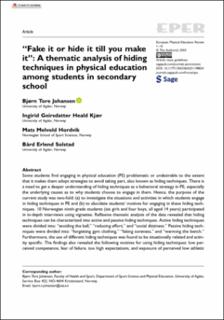| dc.contributor.author | Johansen, Bjørn Tore | |
| dc.contributor.author | Kjær, Ingirid Geirsdatter Heald | |
| dc.contributor.author | Hordvik, Mats Melvold | |
| dc.contributor.author | Solstad, Bård Erlend | |
| dc.date.accessioned | 2024-01-04T15:45:51Z | |
| dc.date.available | 2024-01-04T15:45:51Z | |
| dc.date.created | 2023-09-25T14:15:36Z | |
| dc.date.issued | 2023 | |
| dc.identifier.citation | European Physical Education Review. 2023, Artikkel 1356336X231198824. | en_US |
| dc.identifier.issn | 1356-336X | |
| dc.identifier.uri | https://hdl.handle.net/11250/3109906 | |
| dc.description | This article is distributed under the terms of the Creative Commons Attribution 4.0 License (https://creativecommons.org/licenses/by/4.0/) which permits any use, reproduction and distribution of the work without further permission provided the original work is attributed as specified on the SAGE and Open Access page (https://us.sagepub.com/en-us/nam/open-access-at-sage). | en_US |
| dc.description.abstract | Some students find engaging in physical education (PE) problematic or undesirable to the extent that it makes them adopt strategies to avoid taking part, also known as hiding techniques. There is a need to get a deeper understanding of hiding techniques as a behavioral strategy in PE, especially the underlying causes as to why students choose to engage in them. Hence, the purpose of the current study was two-fold: (a) to investigate the situations and activities in which students engage in hiding techniques in PE and (b) to elucidate students’ motives for engaging in these hiding techniques. 10 Norwegian ninth-grade students (six girls and four boys, all aged 14 years) participated in in-depth interviews using vignettes. Reflexive thematic analysis of the data revealed that hiding techniques can be characterized into active and passive hiding techniques. Active hiding techniques were divided into: “avoiding the ball,” “reducing effort,” and “social dizziness.” Passive hiding techniques were divided into: “forgetting gym clothing,” “faking soreness,” and “warming the bench.” Furthermore, the use of different hiding techniques was found to be situationally related and activity specific. The findings also revealed the following motives for using hiding techniques: low perceived competence, fear of failure, too high expectations, and exposure of perceived low athletic skills. The findings of the current study allow us to reflect on possible ways to organize PE to prevent the use of hiding techniques. | en_US |
| dc.language.iso | eng | en_US |
| dc.subject | passive hiding techniques | en_US |
| dc.subject | real-life vignettes | en_US |
| dc.subject | reflexive thematic analysis | en_US |
| dc.title | “Fake it or hide it till you make it”: A thematic analysis of hiding techniques in physical education among students in secondary school | en_US |
| dc.type | Peer reviewed | en_US |
| dc.type | Journal article | en_US |
| dc.description.version | publishedVersion | en_US |
| dc.rights.holder | © The Author(s) 2023 | en_US |
| dc.source.pagenumber | 16 | en_US |
| dc.source.journal | European Physical Education Review | en_US |
| dc.identifier.doi | 10.1177/1356336X231198824 | |
| dc.identifier.cristin | 2178634 | |
| dc.description.localcode | Institutt for lærerutdanning og friluftslivsstudier / Department of Teacher Education and Outdoor Studies | en_US |
| dc.source.articlenumber | 1356336X231198824 | en_US |
| cristin.ispublished | true | |
| cristin.fulltext | original | |
| cristin.qualitycode | 1 | |
